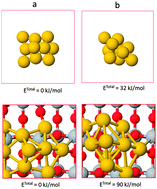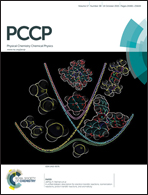Thermally activated surface oxygen defects at the perimeter of Au/TiO2: a DFT+U study†
Abstract
Density functional theory calculations were performed to examine the formation of oxygen atom vacancies on three model surfaces namely, clean anatase TiO2(001) and, Au3 and Au10 clusters supported on anatase TiO2(001). On the Au/TiO2 systems, three different types of lattice oxygen atoms can be identified: the Ti–O–Au bridge, the Ti–O–Ti bridge in the perimeter of the Au cluster and the Ti–O–Ti bridge away from the Au cluster, the oxygen atoms on the clean surface. The variation in ΔG° with temperature for surface O vacancy formation was calculated for these three situations using total-energy, vibrational structure and optimized geometries of the material surfaces and the O2 molecule. The calculations reveal that the O defect formation on the clean anatase TiO2(001) surface seems very difficult due to the large positive value of ΔG° (290 kJ mol−1) from 0 to 650 K. However, the presence of the Au cluster on the TiO2 surface changes the surface chemistry of the TiO2 significantly. We observed that the trend in ΔG° variation for the vacancy formation from the Ti–O–Au bridge is the same as on Au3/TiO2 and Au10/TiO2 systems, almost constant with large positive values of ΔG° around 250 and 350 kJ mol−1, respectively. The ΔG° for the perimeter defect formation (Ti–O–Ti bridge in the perimeter of the Au cluster) is smaller for Aun/TiO2 systems than the clean TiO2 surface, however, the vacancy formation is possible only for the Au10/TiO2 system (close to 506 K). Finally, extended calculations for other oxygen atoms on the Au10/TiO2 model reveal that the trend in ΔG° variation is similar for all the interface or perimeter O atoms around the Au cluster with marginal differences in the numerical value of ΔG°. Since, the surface O atoms are activated only in the presence of a particular sized Au, we propose that a Au catalyzed Mars–van Krevelen mechanism could be a possible reaction mechanism for CO oxidation on Au/TiO2 catalysts at slightly elevated temperatures.


 Please wait while we load your content...
Please wait while we load your content...